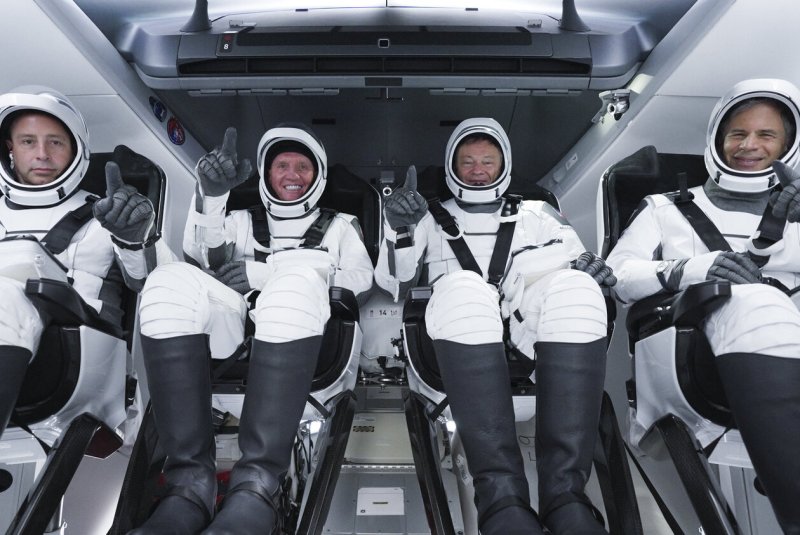1 of 5 | The Ax-1 crew -- Axiom Space's first all-private astronaut mission to the International Space Station --splashed down Monday afternoon in the Atlantic after two weeks in orbit. Photo by Axiom Space/
Twitter
ORALNDO, Fla., April 25 (UPI) -- After nearly a week of delays, the first-ever all private astronaut mission to the International Space Station came to an end Monday, with the crew splashing down in the early afternoon off the coast of Florida.
"Dragon Endeavour has returned, bringing the Axiom-1 crew home," SpaceX officials announced on the livestream. "On behalf of the entire SpaceX team, welcome back to planet Earth and thank you for flying SpaceX."
"To all the people who supported us around the world, thank you," pilot Larry Connor said after landing. "It was an amazing job and an amazing mission."
The craft undocked from the ISS at 9:10 p.m. EDT on Sunday, before backing away from the space station and starting the journey back to Earth.
In preparation for landing, the spacecraft conducted a planned deorbit burn at 12:28 p.m. EDT, with its nosecone closing a few minutes later, in advance of landing.
The SpaceX Dragon capsule carrying four private citizens then splashed down in the Atlantic Ocean at 1:06 p.m. EDT following a two-week stay in space.
Originally scheduled for a 10-day mission, poor weather conditions at the landing site gave the crew -- Michael López-Alegría, a retired NASA astronaut and vice president of business development at Axiom; Larry Connor, a real estate and technology entrepreneur; Mark Pathy, a Canadian businessman; and Eytan Stibbe, an Israeli entrepreneur and former fighter jet pilot -- an extra week aboard the space station.
"Weather in Florida looks beautiful," SpaceX officials said on the landing broadcast. "We are super go for landing."
Splashdown occurred off the coast of Jacksonville -- one of seven potential landing sites around the state of Florida.
Following deorbit burn, the Axiom-1 crew went through a standard communications blackout as they prepared for the Dragon's parachutes to deploy, slowing them down to 15 mph in order to land.
Two drogue parachutes were followed by a quartet of main parachutes, with the Dragon splashing down right on time at 1:06 p.m. EDT.
"Landing in water in simpler and more reliable," SpaceX officials explained during the broadcast. "We had to make Dragon water-proof, but once that happened, it's an easily repeatable cycle of launch and landing."
This particular Dragon spacecraft completed its third flight on Monday, having previously ferried two crews of astronauts for NASA to the space station.
Recovery ships arrived to pluck the crew and Dragon from the water, moving two of the spacecraft's main parachutes out of the water before approaching the craft.
The recovery vessel, Megan -- named after NASA astronaut Megan McArthur -- pulled up to the Dragon after it was determined to be safe. The capsule -- with the crew inside -- was lifted out of the water at 1:33 p.m. and onto the deck of the ship.
A little shaky after spending 17 days in microgravity, the crew was all smiles as they emerged from the Dragon.
"Over the course of this mission, we have inspired people around the world," said Amir Blackman, Axiom's chief business officer. "On behalf of Axiom space, well done and welcome home."
The mission, called Ax-1, is spearheaded by the Houston-based space company, Axiom Space. Working with SpaceX and NASA, Ax-1 is the first non-government, private astronaut mission to fly to the space station.
Led by López-Alegría, the crew spent their time in orbit conducting research designed to help better explain microgravity's effects on the human body.
After undocking from ISS, the crew spent a final night in space ahead of firing Dragon's thrusters to slow down enough and re-enter Earth's atmosphere.
Although it's not an official NASA mission, Ax-1 was carried out with the agency's cooperation as part of a larger effort to foster private-sector utilization of the space station.
Unlike previous tourists who visited the space station, the Ax-1 crew spent more than 1,000 hours training for the flight and most of their days was dedicated to conducting research.
Axiom Space paid for the mission, buying the ride to space on a Falcon 9 rocket and paying for the use of the Crew Dragon spacecraft. The company also footed the bill for the crew training, ground support and use of NASA's space station resources and facilities.
López-Alegría flew as a representative of Axiom, while the other passengers paid for their seats.
The mission is the first in a series of planned private astronaut missions, with the second scheduled to fly sometime in 2023.
That flight will be lead by another former NASA astronaut, Peggy Whitson, who in 2017 became the first woman to command ISS twice and set a since-broken record for longest single space flight by a woman after spending 289 days in orbit.
The missions are part of an effort to develop both research and habitation modules that will be attached to the ISS, and then eventually transition to free-flying modules after the ISS is officially retired.















